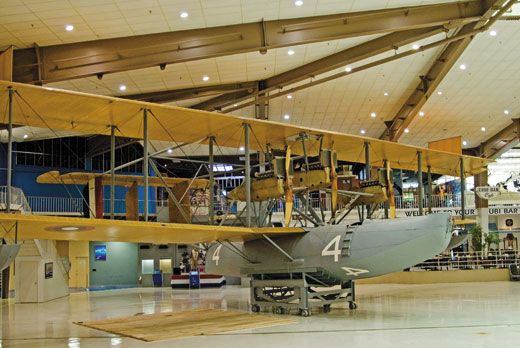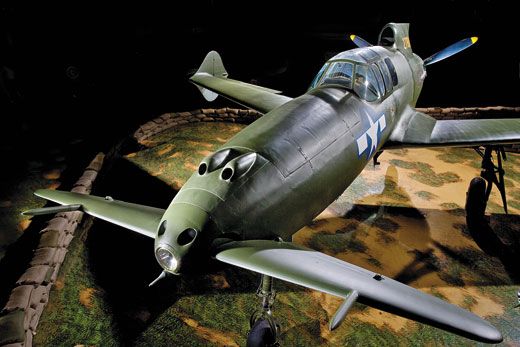The Smithsonian Roadshow
Can’t make it to the Museum? There might be an artifact on loan right in your neighborhood.
/https://tf-cmsv2-smithsonianmag-media.s3.amazonaws.com/filer/Museum-Martin-Mariner-3-flash-631.jpg)
Millions of people come to Washington, D.C., every year to see the exhibits at the National Air and Space Museum, but what if you can’t make the trek? Luckily, the Smithsonian Institution loans artifacts to museums all over the country, and some of its most interesting pieces might be right in your neighborhood.
Smithsonian Affiliations is responsible for coordinating loans from the Institution’s extensive collections, like fossils from the National Museum of Natural History, classic-movie costumes from the National Museum of American History, or paintings from the American Art Museum. Any museum around the world can request a Smithsonian artifact, and can speed up the process by joining the 173 museums in the Affiliate Network.
If a museum wants to borrow, say, an astronaut glove or an Apollo command module, it needs to work with Hunter Hollis, the loan manager for the National Air and Space Museum’s space history division. “Museums come to us with ideas for exhibition themes that revolve around air and space artifacts,” he says. “If the ideas are solid and well thought out and the museum’s facilities are satisfactory, we work with them to find artifacts in our collections.”
Here are just a few items from the Smithsonian collection on loan today.
Curtiss NC-4
National Museum of Naval Aviation, Pensacola, Florida
Almost a decade before Charles Lindbergh made his famous nonstop solo flight across the Atlantic, the U.S. Navy paved the way with the Curtiss NC-4. During World War I, while Allied ships were under constant attack from German U-boats, the Navy came up with the idea to use the NC-class flying boats for anti-submarine patrols. The test of the craft’s ability to cross the Atlantic began on May 8, 1919, from Rockaway Beach, New York. Though teamed up with two other NCs, only the NC-4 and its six-man crew made it all the way to Portsmouth, England—a 24-day trip with stops in Nova Scotia, Newfoundland, the Azores, and Portugal. The Smithsonian acquired the airplane in 1920, and in 1969 displayed it on the National Mall to celebrate the 50th anniversary of this historic flight. The NC-4 then made its way to Pensacola in 1974.
Curtiss XP-55-CS Ascender
Kalamazoo Aviation History Museum, Michigan
According to the Smithsonian’s records, the Ascender was one of three “radical and unorthodox fighter aircraft designs” that the U.S. Army Air Corps tested in the run-up to World War II. Each one incorporated a pusher powerplant (a propeller in the rear that pushes the aircraft, rather than pulling it), but the XP-55-CS was special. The main wing sat at the rear of the fuselage, behind the cockpit, while a canard was placed near the nose. The Museum explains the experimental airplane’s place in history: Testing showed the “performance and handling too poor for an effective combat fighter, but it did demonstrate exactly where future trends in fighter design should not go.”
Apollo 13 command module Odyssey
Kansas Cosmosphere and Space Center, Hutchinson, Kansas
On April 13, 1970, the Apollo 13 mission was already 200,000 miles from Earth when the no. 2 oxygen tank in its service module exploded, causing the valves to close on the fuel cells that provided electricity to the command module Odyssey. The moon landing was aborted, but the astronauts made their way back to Earth, eventually jettisoning the lunar and service modules and splashing down safely in the command module. Odyssey now sits on display at the Kansas Cosmosphere, where you can also see the Gemini 10 capsule and the prototype of NASA’s Surveyor 1, which in 1966 became the first U.S. spacecraft to land on the moon. Both are Smithsonian artifacts.
Maupin-Lanteri Black Diamond
Hiller Aviation Museum, San Carlos, California
The Black Diamond, built by Lan Maupin and Bernard Lanteri, was a rare amateur success in the first years of experiments with airplanes. A wood-and-fabric biplane with a 50-horsepower engine in the pusher configuration, it was modeled after the early Curtiss biplanes. Maupin and Lanteri added their own touches and sent it off to compete in races, where it broke flight duration and altitude records in 1911 and 1912.
Martin PBM-5A Mariner
Pima Air & Space Museum, Tucson, Arizona
This last-of-its-kind bomber was a little-known but very successful long-range patrol aircraft. During World War II, the Consolidated PBY Catalina was initially the first choice for such missions, but toward the end of the war, the faster, larger, and more powerful Martin PBM Mariner flying boat replaced it. Of the 1,366 Mariners built, however, only one survived. It was passed around in the Navy, first flying with a patrol squadron and then used as a trainer until its retirement in 1953. Sold as government surplus, the aircraft was flown in a number of roles, including service as a firefighting water tanker and a fish hauler. The airplane was donated to the Smithsonian in 1972 and went to Tucson later that year.

